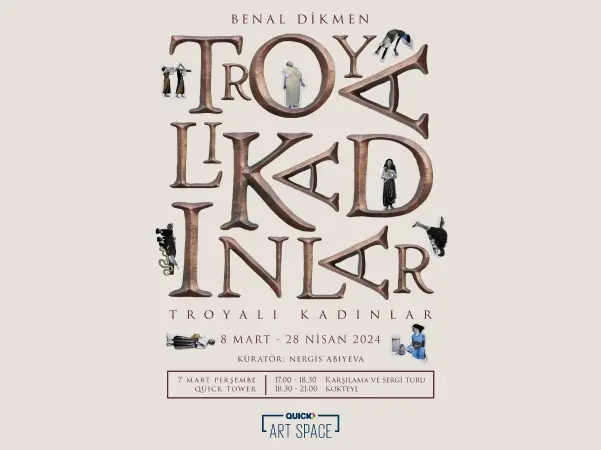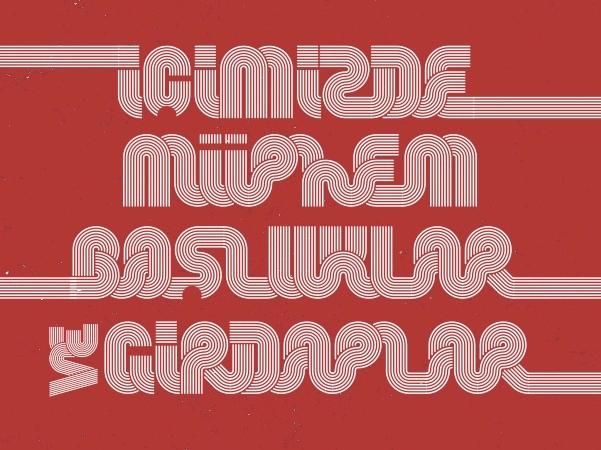Constructed Nature
The landscapes we build, whether real (our gardens) or fictional (our dreams), follow the same path as our word play.1
I have curated the first exhibition at Quick Art Space based on the architectural features of the building and the way it positions itself. When I first visited Quick Tower in April this year, I was impressed by the building as well as how it relates to its surroundings. Dogs using the revolving door that opens to the lobby with huge windows, the lush, vibrant trees around the building, crows perched on trees, cats sleeping inside, all these show that this is also a living space for non-human creatures. The appealing, embracing atmosphere of Quick Tower, designed by Gerhard Feldmeyer, a Vienna-based architect, located in the heart of Kozyatağı, where thousands of visitors spend time or pass by on a daily basis, immediately convinced me that I could make “unexpected exhibitions” beyond the white cube experience.
What made me think this place was a “natural” living space as it had actually been transformed, planted, and afforested? Is it only old-growth forests or vast seas that serve nature? Or, if properly intervened and healed by human hands, could urban areas also be capable of strengthening our relationship with nature? How far can we move beyond the binary oppositions such as nature vs. culture, human vs. animal, male vs. female, mind vs. body, work vs. home?
The rise of modern cities where space is defined, categorized and parceled out led to the invention of the notions of landscape and scenery. Construct refers to things created with imagination. This word, as well as its implications, drew my attention while reading Bilge Karasu’s book Ne Kedisiz Ne Kitapsız [Neither Bookless nor Catless]. In his article titled “The Novel Still Ranks First in Image Production”, Karasu says the following.
I presume that our life is comprised of a continuous production of artifacts. We are constantly living in a construct, or what we experience (as an important or unimportant, heavy or light, strong or faint element) constitutes the construct we call our life. The elements of this larger construct are more limited, smaller artifacts. Roughly speaking, do I argue that there is no such thing as “reality”? Not at all. I mean that we perceive, comprehend, make sense of, think about, understand what is called “reality” only with the help, mediation, and “creation” of certain constructs. I call these constructs images.2
Constructed Nature is, in a sense, a continuation of Mental Imagery of Things not Actually Present, a group show that Uras Kızıl and I curated at Summart in 2021. As a matter of fact, Özlem Şahinler’s work titled “I am You” organically connects the two exhibitions. In this work, she considers her hair a micro-ecosystem and a hosting space where multiple interdependent species stray as inhabitants, and she reveals different forms of existence of a living system from her hair strands. Thus she emphasizes that what we think of as “me” is actually “us”. These beings in unique forms try to breathe in an anonymous geography with their identities that harbor a common essence. This work imagines the transformative process of various living anatomies “that have existed from a single essence again becoming a single essence” and reminds us that the changing and transforming living beings do constitute a whole.
We also have six paintings from Nazan Azeri’s “Forgotten Time and Now” series in the exhibition, the first examples of which she started in Ayvalık in the summer of 2021. Painted with blue and red acrylic ink on handmade paper, this series can be read as a rebellion against the nature culture dichotomy. Questioning the systems that reproduce inequality built on the binary opposition between culture (masculine) and nature (feminine), the blue color in Azeri’s paintings references the Far East, Anatolia, the Topkapı Palace Circumcision Room tiles, and the ancient paintings of Egypt. Azeri adopts a “killjoy” style, reconsidering the symbolic meanings of blue and red in works from the history of art. Her “Forgotten Time and Now” series brings to mind Yves Klein’s use of naked women as human paintbrushes in his patented Klein blue or Leonardo da Vinci’s “Vitruvian Man” drawing, which puts the adult male human in the centre of the world. Azeri’s series is a silent feminist response to the canon of art history made/written by male artists.
Gülçin Aksoy, as an artist who frequently uses the idiom “constructed nature”, has produced a new work titled “Reticulus volvulus” for the exhibition. According to Aksoy, a work of art is an artifact. More precisely, based on the distinction between human and nature, it is what is added to nature, which is deemed “unnatural” —that is, produced by humans. This discourse speaks outside the human vs. nature distinction, and the work of art or the human being exists as a part of this world and universe. In this case, we can understand our “doings” as natures added to that nature. Therefore, Aksoy is interested in human-made natures: What looks like a representation of a tree is a tree in the common imagination, but it is not a tree we can sit under. So is the image of a woven tree. Ergo, producing, distributing, pixelating such a tree is not an act outside the nature. As a pun she has invented, “Reticulus volvulus” refers to Latin medical terms. Produced with “natural materials”, this diptych work, one woven and the other stacked on top of each other, points to a world transformed by culture using the written signs depicting the human condition, which we have separated from nature for thousands of years, although itself transformed. Things that are written, drawn, crumpled up… They are transformed by communing with paper. The threads become entangled with each other. They seem to be involved in a complicated but attractive world.
Seçil Büyükkan’s work, produced as part of “Roots Far from the Ground” series, first exhibited at the Atatürk Cultural Centre, is separated from the soil as the source of life, standing alone in a gigantic way. Standing vertically before us like a large and lofty cathedral, this work has already taken its place in our printing history as a work that Büyükkan made with linoleum moulds single-handedly, thus pushing the limits of printing techniques. In dialogue with both the trees around Quick Tower and Gülçin Aksoy’s work, “Roots Far from the Ground” makes us think that the concepts of reality and imagination are intertwined and the question of “pictorial representation” remains.
Ekin Saçlıoğlu’s “Childhood”, previously shown at ArtSümer’s Fragmented exhibition, is another sculpture/work that reinforces the show, which she created by transforming the wooden skeleton of the sofa she spent her entire childhood on. Saçlıoğlu started sculpting furniture during the pandemic, based on the idea that while spending time at home, we mesh with inanimate objects in our homes and become a part of each other. The colorful pieces that make linear movements on the wooden skeleton belong to the roots of tamarisk trees that hit the Palamutbükü beach in Datça with the lodos. She places the waste styrofoam green form on the skeleton without any intervention. This work, which brings to mind a panoramic view with the upper part of the sofa as the horizon line and the entire work as the sky and the sea, returns to the Kozyatağı neighborhood where Saçlıoğlu spent her childhood on the occasion of Constructed Nature. When we look at a landscape, do we interpret it solely through what we see, or is it a “thing” that is influenced by our memory or autobiographical narratives?
Ahmet Rüstem Ekici and Hakan Sorar’s “Theatrum Mundi”, a triptych video installation, is inspired by the idea that the world is a stage. This interactive experience is presented on three screens with introduction, body and conclusion stages, making the viewer a part of the experience, transforming them into an “experiencer”. This scene is designed not to be limited to a single angle or perspective, instead offering the experiencer the opportunity to observe the landscape from their own preferred angles, to change the sound, color and weather conditions. This experience encourages reflection on the mechanisms of control and the limits of personal freedom. On this artificial stage, where the distinction between the virtual and natural world is blurred, the viewer takes on the roles of a director, set designer and gaffer, focusing on urban and bodily traces in environmental relationships. The experiencer is entitled to shape the landscape with more than twenty control buttons and variations on the panel. This work provides the experiencer with multiple perspectives by allowing them to question the environmental relations of nature, destruction and the body. “Theatrum Mundi” creates a scene that is not limited to a single perspective thanks to the capability to manage the flow of the work with control buttons. On the other hand, it questions the nature of the image and the centre.
All of the artists who contributed to the Constructed Nature visited Quick Tower. We had tea and coffee with some of them in the lobby, some under the shading trees. We took a walking tour with some of them in the greens of Fatih Sultan Mehmet Hospital and petted cats. And with others, we sat in the square, sharing silence, watching the cats and dogs frequenting the building. I am sure that Constructed Nature, created with seven artists who adopt different languages in art-making, has also been shaped by the unique banalities of our daily lives that we experienced together.
Nergis Abıyeva
October 2023, Erenköy
Translated by Zeynep Nur Ayanoğlu
1Anne Cauquelin,Peyzajın İcadı, Dost Publishing, p. 78.
2Bilge Karasu,Ne Kitapsız ne Kedisiz, Metis Publishing, p. 17.




